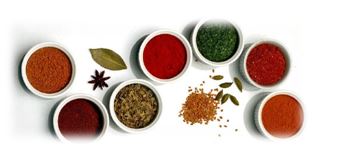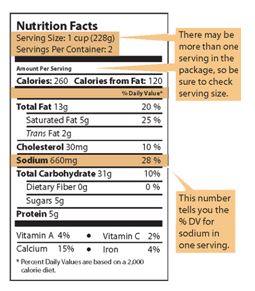The Low Down on Sodium
Salt seems to be lurking everywhere in the American diet because
it tastes good, and it preserves our food.
But the body only needs 200-500mg a day, while the average American
gets about 3,400 mg!
How much do I need?
US Dietary Guidelines recommend limiting sodium to less than 2,300 mg a day
1,500 mg a day is appropriate for people who:
 - Are 51 years of age or older,
- Are 51 years of age or older,
- Are African-American
- Have hypertension, diabetes or chronic kidney disease.
Why do I care?
Excess sodium causes the body to hold onto water, forcing the heart to work harder, and raising blood pressure. Limiting sodium in your diet prevents this high blood pressure that may lead to heart disease and stroke.
Not to fear…Salt is an acquired taste, which means that your taste buds can be retrained, and your desire for that saltiness will actually decline over time!
How do I cut back on sodium?
Step 1- Put away the saltshaker and reduce or eliminate salt in cooking. Just 1 teaspoon of salt contains 2,300 mg of sodium Instead, experiment with spices, garlic, onions or lemon for a burst of flavor
Just 1 teaspoon of salt contains 2,300 mg of sodium Instead, experiment with spices, garlic, onions or lemon for a burst of flavor


Step 2- Know where it lurks
Most of the sodium in our diet comes fromprocessed, cured, canned, instant, pickled, and frozen foods.
*Remember: foods do not necessarily need to taste salty to contain sodium. Many breakfast cereals have the same amount of sodium as a serving of chips!
Step 3- Always choose fresh
Fresh beef, poultry, fish, beans, rice, and pasta have significantly less sodium than their processed counterparts.
Limit bacon, sausage, hot dogs, ham, luncheon meats, and corn beef
Load up on fresh fruits and vegetables, or those frozen or canned with no added ingredients are very low in sodium

Step 4- Read the label
Check the back nutrition facts label to see how a serving of food would impact the daily goal of less than 2,300 mg of sodium
*Tips to better understand food labels
| Sodium Free- | Trivial amount of sodium per serving |
| Very Low Sodium- | 35 mg or less per serving |
| Low Sodium- | 140 mg or less per serving |
| Light/lite in Sodium- | Sodium is reduced by 50% from non-reduced food item |
| Reduced Sodium- | Sodium is reduced by 25% from non-reduced item |
Step 5- Go the extra mile
 Rinse your canned goods at home: Canned foods are loaded with excess sodiumBy rinsing canned beans and vegetables in a strainer under cool water you can reduce their sodium content by about 40%
Rinse your canned goods at home: Canned foods are loaded with excess sodiumBy rinsing canned beans and vegetables in a strainer under cool water you can reduce their sodium content by about 40%
A quick extra step that makes all the difference!
Request low sodium at restaurants: Restaurants tend to use a lot of salt
- Order your entrée grilled, baked or broiled instead of fried or breaded.
- Get your dressings or sauces on the side
- Avoid bacon bits, cheese and croutons at the salad bar
*Don’t be afraid to ask your server about lower sodium options, or if the chef can use lemon, wine, herbs, or spices to add some flavor to your entrée without salt!